| |
Astronomers have discovered a faint blue galaxy about 30 million light-years from Earth that could shed new light on conditions at the birth of the universe.
| |
The galaxy nicknamed Leoncino, or "little lion," located in the constellation Leo Minor, contains the lowest level of heavy chemical elements, or "metals" ever observed in a gravitationally bound system of stars. "Finding the most metal-poor galaxy ever is exciting since it could help contribute to a quantitative test of the Big Bang," said John J Salzer, a professor at Indiana University in the US. "There are relatively few ways to explore conditions at the birth of the universe, but low-metal galaxies are among the most promising," Salzer said. This is because the current accepted model of the start of the universe makes clear predictions about the amount of helium and hydrogen present during the Big Bang, and the ratio of these atoms in metal-poor galaxies provides a direct test of the model. In astronomy, any element other than hydrogen or helium is referred to as a metal. The elemental make-up of metal-poor galaxies is very close to that of the early universe. "Low metal abundance is essentially a sign that very little stellar activity has taken place compared to most galaxies," said lead author Alec S Hirschauer, a graduate student at Indiana University. Leoncino is considered a member of the "local universe," a region of space within about 1 billion light years from Earth and estimated to contain several million galaxies, of which only a small portion have been catalogued. A galaxy previously recognised to possess the lowest metal abundance was identified in 2005; however, Leoncino has an estimated 29 per cent lower metal abundance. The abundance of elements in a galaxy is estimated based upon spectroscopic observations, which capture the light waves emitted by these systems. Regions of space that form stars, for example, emit light that contains specific types of bright lines, each indicating the atoms from various gases: hydrogen, helium, oxygen, nitrogen and more. In the light of the star-forming region in Leoncino, scientists detected lines from these elements, after which they used the laws of atomic physics to calculate the abundance of specific elements. Aside from low levels of heavier elements, Leoncino is unique in several other ways. A so-called "dwarf galaxy," it is only about 1,000 light years in diameter and composed of several million stars. The Milky Way, by comparison, contains an estimated 200 billion to 400 billion stars. Leoncino is also blue in colour, due to the presence of recently formed hot stars, but surprisingly dim, with the lowest luminosity level ever observed in a system of its type. | |
Wednesday, 18 May 2016
Rare blue galaxy may shed new light on Big Bang
India successfully test fires indigenously developed nuclear capable Prithvi-II missile
India has successfully test fired indigenously developed nuclear capable Prithvi-II missile as part of a user trial by army from test range at Chandipur in Odisha.
| |
Inducted into India's armed forces in 2003, Prithvi II, is the first missile to be developed by DRDO under the prestigious Integrated Guided Missile Development Program. Notably, Prithvi is India's first indigenously-built ballistic missile. Prithvi-II has been designed to operate with both liquid and solid fuels and is capable of carrying both conventional and nuclear payloads. The last user trial of Prithvi-II was successfully conducted on February 16, 2016, preceded by a trial on 14th of November 2014. | |
Thursday, 12 May 2016
Parliament House (India)
History
Originally called the House of Parliament, it was designed by the British architect Edwin Lutyens and Herbert Baker in 1912-1913 and construction began in 1921. The opening ceremony of the Parliament House, then called the Central Legislative Assembly, was performed on 18 January 1927 by Lord Irwin, the then Viceroy of India. The third session of Central Legislative Assembly was held in this house on 19 January 1927.
The Parliament Museum, opened in 2006, stands next to the Parliament House.
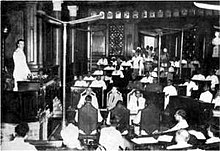
Rear Admiral Lord Mountbattenaddressing the Chamber of Princes asViceroy in 1947
The shape is circular, which is based on the Ashoka Chakra. Separate halls were constructed for the sessions of the Chamber of Princes, the State Council, and the Central Legislative Assembly.
The building is surrounded by large gardens and the perimeter is fenced off by sandstone railings (jali) modeled after the Great Stupa of Sanchi.
Central Hall
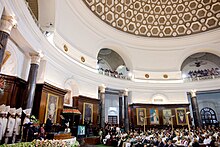
U.S. President Barack Obamagiving a speech to both houses in a Joint Session of the Parliament in the central hall (November 2010)
The Central Hall of the Parliament is designed to be circular in shape. The dome is 98 ft. (29.87 metres) in diameter and is believed that it is one of the most magnificent domes in the world. The Central Hall is a place of historical importance in India for two reasons: The transfer of colonial power to the Provisional Government under Nehru in 1947 and the framing of the Constitution by the Constituent Assembly took place in this very hall. At present, the Central Hall is used for holding Joint Sittings of the two Houses. At the commencement of the first session after each General Election to Lok Sabha and at the commencement of the first session of each year, the President addresses both the Houses of Parliament assembled together in the Central Hall. When the Houses are in session, the Central Hall is used by Members for informal discussions among themselves. Central Hall is also used for special occasions when the Members of Parliament are addressed by distinguished Heads of States of other countries. The Hall is also equipped with Simultaneous Interpretation System.
Proposal for a new building.
A new Parliament building may replace the existing complex. The new building is being considered on account of the stability concerns regarding the current complex. A committee to suggest alternatives to the current building has been set up by the ex-Speaker, Meira Kumar. The present building, an 85-year-old structure suffers from inadequacy of space to house members and their staff and is thought to suffer from structural issues. The building also needs to be protected because of its heritage tag.
Monday, 9 May 2016
The Untold Stories Of Mahatma Gandhi

I feel like a kid who is receiving a lot of awards and gifts today.
Today is a day of gifts.
It is often said, ‘Life itself is a gift from God, to all of us.’ Let us honor this gift.
Today I thank the Morehouse College, the Dean, the President and all the dignitaries here who have found me worthy of getting this award and bestowing this award to me.
I rededicate this award to all those who work ceaselessly in their silent manner, in their little corners, in their community for peace and non-violence.
This recognition of peace and non-violence as a driving force for social change, social justice is noteworthy.
There are medals for war, people who fight in wars do get medals. But getting a medal for peace and non-violence, in itself, changes the paradigm of society.
Unfortunately, in the last several decades, aggression has got itself attached to pride. It is time now, that we reverse this tendency. Pride should be in non-violence and in peace.
When we were growing up as children, we grew up with stories of Mahatma Gandhi. I want to tell you about my teacher who is still alive, and who has completed 118 years of his life today. This gentleman taught Mahatma Gandhi the scripture, Bhagavad Gita, when he came back from South Africa. And he was with him for 40 years as his tutor, and also as his writer.
He used to be the translator and script writer for the southern languages. His name is Pandit Sudhakar Chaturvedi.
So he used to tell us the stories or the incidents he had with Mahatma Gandhi. Some of them are not recorded, so you don’t find them in any books. I would like to narrate a few such stories which might inspire you.
One incident was when Mahatma Gandhi was travelling in a small train uphill to Darjeeling. Darjeeling is a hill station in India, and you have a small train that goes there. It is a narrow gauge train. Now what happened is that, when the train was moving up the hill, somewhere, the engine got itself disconnected from the coaches. So the engine went ahead and the coaches started sliding backward.
Just imagine on a big hilly terrain, coaches are sliding backward, what would happen? There was huge panic, as people were between life and death. Any moment the coaches could fall off the hill, and one would not even find a trace of a bone. It was the Himalayas.
So while there was panic all around, Mahatma Gandhi was dictating letters, and he said to my teacher; he used to call him Bangalori, because he was from Bangalore; ‘Bangalori, take dictation.’
My teacher said, ‘Bapu (father, referring to Mahatma Gandhi), do you know what is happening? We may not be alive. We are in-between life and death. The coaches are moving backward with nothing to stop it, and its gaining speed.’
Do you know what Mahatma Gandhi said then? He said, ‘Suppose we get saved, we would have wasted all this time. If we die, we die. But if we are saved, we wasted so much time? So, come on, take dictation.’
With trembling hands my teacher was taking dictation.
He used to tell me, ‘Look at this old man, he would not waste a moment of his life.’
There is another story I would like to share with you.
Once Gandhi’s dhoti, i.e., his garment was torn, and someone said, ‘Bapu, your dhoti is torn.’ So Gandhi goes into the bathroom and adjusts his garments a little bit, and then says, ‘See now, and tell me where it is torn? There is a lot of it left to get torn.’
So his idea was not to waste resources; not to be a consumerist by nature.
There is enough for everybody’s need, but not for everybody’s greed - this was the message he used to give.
Gandhi had such a soft heart like that of a child; innocence of a child.
What is needed today is the innocence of Gandhi, and the valor, vigor, commitment and vision of Martin Luther King Jr. These two things combined together, is the answer for the situation we are in today.
I won’t say that Gandhi’s principles alone will work in today’s scenario. If you are fasting, people will say, ‘You keep fasting, never mind. You can do that much good for the world.’ You need along with that, the heart and the commitment that Martin Luther King had shown to the world. Then it makes it complete, and then social justice, and the much needed revolution in today’s world would come forth. And it has to come forth from the youth of today. All of you who are sitting here, you have to stand up for non-violence.
In the United States of America, last year alone, there has been ten million recorded incidents of violence. Violence against children, violence against women, violence against races, violence against religious groups, etc. Intolerance is growing in society. But we don’t need to panic, because truth and non-violence will always win.
What we need to do is to create a billion acts of non-violence. For every act of violence, we have to create hundred acts of non-violence. The voice of non-violence has to be heard loud and clear. This is what we need.
We all sang today, ‘We will be the change that we want to see in the world.’ So the change starts from right here, where we are; from each one of us.
Another incident of Mahatma Gandhi that my teacher used to share.
My teacher was in Yerwada jail, along with Mahatma Gandhi. There were only three of them, Mahatma Gandhi, Mahatma Gandhi’s wife Kasturba Gandhi, and my teacher.
This incident is of the last day of Kasturba Gandhi. She was on her death bed, and Mahatma Gandhi comes out of the room, and he says, ‘Bangalori, today is the day of my trial. Today is the day to see how I can maintain my equanimity. How I can see everybody in the same way. Today is the day of my test.’
As he was saying these words, drops of tears were flowing down his eyes.
My teacher said, ‘I have never seen him in that state ever before. But those drops of tears said it all.’
Mahatma Gandhi said, ‘Today, I have to say good-bye to my companion of 40 years. She was my strength, she was my inspiration, and she was the one who took all my garbage, all my weaknesses and who swallowed it and stood by my side. Now, today, I have to keep myself in equanimity. Today is the test of my spirituality.’
So, these moments in life, where you personally observe, watch, understand yourself, and see what is happening within you, makes a big difference in your life.
Who are you? What do you want, and what do you want to convey? Observing this, makes a difference.
Do you know, neither at school, nor at home, does anyone learn how to get rid of negative emotions, or how do be centered, or how to feel belongingness with everyone. This is exactly what we need today. We need to reach out to communities.
Communities can no longer remain as isolated groups. Each community should come and shake hand with the other communities.
I am so happy that the Ikeda Foundation is also involved here and they are doing such good work in so many countries, bringing different communities together.
The teachings of Buddha, the teachings of Jesus and the teachings of Krishna, they all point towards one thing, that we are all made up of love, and we are love. Let us live this. Let us find an expression to this. Let us recognize this spirit in each one of us.
The message of Jesus is, ‘You are love and God is love.’ The interfaith community has a bigger role to play today, of uniting the fragmented communities, and reaching out to all those people who are engaging in violence. This is inclusive of domestic violence and societal violence. Also, being violent towards oneself, is a thing to be considered.
Many people eventually commit suicide because they are too hard on themselves. Thousands of people are committing suicide in the world today. Depression is taking such a big toll. In these circumstances, we all have to raise our voice and work towards non-violence.
A while back, I was in South America, in Mexico, at the traffic light signal, there was an argument between two taxi drivers. They both got out of the car and shot each other. There were passengers sitting in the taxis and they didn’t know what to do. The drivers were gone. Intolerance and stress have to be attended to.
Let us all join together and in this year create one billion acts of non-violence, acts of friendship, and acts of compassion. Our children should get a better world than what we have inherited.
No, Mercury Retrograde Will Not Mess Up Your Life
For people of the astrological persuasion, few planetary trends are as noteworthy as Mercury in retrograde. As the solar system's smallest planet appears to reverse through the sky, you'll hear it blamed for a wealth of frustrating situations, including overspending on new purchases, poorly planned work pitches and unimpressive first dates.
The common astrological advice for people during Mercury retrograde is to avoid starting anything new and to focus instead on reassessment, mimicking the way the planet appears to be retracing its own movements. In 2016, Mercury retrograde will occur four times, totaling about 80 days. That is a lot of time for reassessment.
Astronomers tend to disagree with these associations. "The idea that the gravity from these very distant bodies affects our lives in some way just doesn't work in the framework of physics," said Jean-Luc Margot, a planetary astronomer and professor at UCLA.
Finding the facts about Mercury's retrograde motion is complicated because it's both a real and imagined phenomenon. "All the planets rotate around the sun in the same direction, and that never changes," Margot said. However, if a person were able to trace Mercury's position during retrograde — which is a challenge, because the sun blocks our view — they'd end up with a line that changes direction. This is because Mercury retrograde is an optical illusion resulting from our position (on Earth) relative to Mercury.
The term "retrograde" in this instance refers to a perceived reversal in the standard west-to-east movement of Mercury through the stars. While some objects in space do experience true retrograde motion — Venus spins about its axis in the opposite direction than the other planets, a situation called retrograde spin — Mercury's backtracking is an issue of perspective. Its orbit is smaller and faster than Earth's. When its orbit catches up to and passes Earth, it creates the illusion that Mercury is backtracking, astronomers say.
Put more plainly, pretend you're Earth, watching Mercury run around a track. As it runs its loop, it will start out moving from the left side of your field of vision to your right. Then, it rounds the corner and, although not moving backward, is now running from right to left. This analogy is oversimplified because it doesn't take into account the fact that Earth is also moving, but it gives a good idea of how this optical illusion plays out.
All of the planets exhibit apparent retrograde motion, although it plays out slightly differently for planets farther from the sun than Earth versus those, like Mercury, that are closer to the sun than Earth.
Pseudo planetary effects
As for the potential influence of this seemingly odd movement on our daily lives, science doesn't back it up. In his 1974 book "The Jupiter Effect" (Walker Books), writer John R. Gribbinpredicted that the alignment of all of the planets and the sun on the same side of the Earth would have catastrophic effects.
James Zimbelman, a geologist at the Center for Earth and Planetary Studies at the Smithsonian's National Air and Space Museum, said this prediction actually prompted some scientists to look into the magnitude of the gravitational effects of planetary objects on Earth. "The net result of all of that was, the force is so small compared to either the sun or the moon, that any kind of planetary effect would just be swamped by the things the Earth is always feeling by either the sun or the moon," Zimbelman told Live Science.
(For reference, Margot said the gravitational effects a person experiences when standing next to another person are thousands to tens of thousands of times greater than the gravitational forces exerted on them by the moon.)
The vast number of internet sources mentioning Mercury's retrograde are astrological sites, which then go on to offer advice on how to combat its influence. Mars' apparent retrograde motion is the most obvious of the retrogrades because people can easily view Mars in the night sky as it is the closest planet and, unlike Mercury and Venus, doesn't require a person to look at the sun in order to observe it. This apparent retrograde motion garners much more notice from educational sources. Of the three experts contacted by Live Science, all three considered Mercury retrograde fairly unworthy of discussion.
"All planets appear to go through a period of retrograde (east-to-west) motion against the stars as seen from the Earth," Geoff Chester, a spokesman for the U.S. Naval Observatory, wrote in an email to Live Science. "There is nothing unusual in this. Mercury is no exception. There is no story here."
The Mercury transit
Even if retrograde isn't worthy of much scientific thought, it does overlap with a more exciting astronomical event. About once every 10 years, while Mercury is passing Earth, everything lines up just right, and Mercury crosses in front of the sun from our point of view on Earth. This is called the transit of Mercury and will occur on May 9
Enjoying the transit may be perhaps the greatest, clearest effect Mercury retrograde can have on your life.
New Print-Out Lasers Are So Cheap They're Disposable
Everyone's heard of disposable razors, but what about disposable lasers? Using inkjet printers, scientists have made laser devices cheap enough to be thrown out after a single use.
Lasers create their high-energy beams using a so-called gain medium, which takes advantage of the interactions between the electrons of its atoms and incoming photons to amplify light to high intensities. Typically, the gain medium is made from inorganic materials such as glasses, crystals or gallium-based semiconductors, but in recent years, researchers have investigated using organic carbon-based dyes instead.
Organic lasers hold great promise because they are low-cost and can emit light in a wide range of wavelengths, but they are limited because the dyes degrade rapidly.
Now, researchers from France and Hungary have used inkjet printers to produce the organic laser chips at the heart of these devices for mere cents, making it cost-effective to regularly replace the degraded parts.
"I think that this is an exciting piece of work with great potential for applications," said organic laser expert Graham Turnbull, a professor in the School of Physics and Astronomy at the University of St Andrews in Scotland. "The lasers could have future applications as disposable light sources for chemical analysis such as medical screening or pollution monitoring," Turnbull, who was not involved in the new study, told Live Science.
In a paper published today (May 3) in the Journal of Applied Physics, the researchers said the key to their approach's low cost is its efficiency. The most popular method for creating organic laser chips in the past has been spin coating. In this process, the surface on which the dye solution is to be deposited is spun rapidly so that centrifugal force spreads the liquid evenly to form a uniform thin film.

Inkjet printed "lasing capsules" serve as the core of an organic laser. Figure (a) shows a schematic of the laser setup, while figure (b) shows actual lasing capsules, which would cost only a few cents to produce. OC stands for "Output Coupler" and FP stands for Febry-Perot etalon.Credit: Sanaur, et al/JAP
But with typical spin-coating techniques, the vast majority of the dye solution spins off the surface and thus is wasted; as little as 2 percent is actually deposited usefully, the researchers said. In contrast, inkjet printers can accurately squirt small jets of fluid onto the underlying material, they added.
"You print 'where you want, when you want,' without wasting raw materials," study lead researcher Sébastien Sanaur, an associate professor of microelectronics at the Ecole Nationale Supérieure des Mines de Saint-Étienne in France, said in a statement.
For the laser dyes to be printed, they first needed to be mixed with an ink. Although the researchers experimented with inks specifically designed for optical applications, they eventually settled on a commercial variety called EMD6415 that exhibited excellent printing and optical properties.
Then, the solution was printed onto a slide made of quartz in 0.08-square-inch (50 square millimeter) pixels to make the laser chip. The chip was placed between two mirrors that reflected light back and forth through the gain medium during amplification. Another laser, known as the pump, was used to provide the light energy input, the researchers said.
Importantly, the scientists said the laser chip can be switched out easily when it deteriorates. They also demonstrated that they could use two different dyes to produce laser emissions ranging in color from yellow to deep red.
"The major advance here is the perfection of the inkjet printing process for the fabrication of organic 'gain' chips," said Stéphane Kéna-Cohen, an assistant professor in the Department of Engineering Physics at Polytechnique Montréal in Canada. "When used in a laser cavity, these can be used to fabricate broadly tunable lasers, and several dyes exist that together can span the entire visible spectrum," Kéna-Cohen, who was not involved with the new study, told Live Science.
Both Kéna-Cohen and Turnbull said one of the most promising aspects of the research is the possibility of printing several dyes onto the same chip to generate a spectrum of colors with the same device.
"The major obstacle, however, is that these organic lasers still need to be pumped by an external, relatively high-energy laser," Kéna-Cohen said. "Finding a way to pump these electrically or with a low-cost LED would be a major breakthrough for many practical purposes."- See more at: http://www.livescience.com/54632-disposable-lasers-made-from-inkjet-printers.html#sthash.wpz9uo7h.dpuf
Mercury's rare 'transit' across the sun today: Here's how you can see it
The celestial event will be visible from all parts of India for varying durations depending on the location, starting around 4:40 pm.
Stargazers will have a rare opportunity on Monday to witness Mercury fly directly across the face of the sun, a sight that unfolds once every 10 years or so, as Earth and its smaller neighboring planet come into perfect alignment.
In Delhi, Mumbai, Kolkata and Chennai, the event will begin at 4:41 pm.
In Delhi, the event can be seen for a duration of about 2 hours 20 minutes, in Kolkata about 1 hour 26 minutes, in Mumbai about 2 hours 24 minutes, and in Chennai about 1 hour 45 minutes.
Dwarka in Gujarat will experience the longest transit (2 hour 43 minutes).
Port Blair in the east will see it for only 54 minutes.
In Shimla and Chandigarh the event can be seen for over 2 hours.
It will be difficult to see the Mercury at transit over the face of the Sun without some form of aid such as binoculars or telescopes.
The Earth Sciences ministry suggested that a proper solar filter will be required to avoid viewing the sun with the naked eye such as aluminized mylar, black polymer or welding glass of shade number 14
Mercury is too small to see without high-powered binoculars or a telescope, and looking directly at the sun, even with sunglasses, could cause permanent eye damage.
Fortunately NASA and astronomy organizations are providing virtual ringside seats for the show by live-streaming images of the transit in its entirety and providing expert commentary.
The tiny planet, slightly larger than Earth's moon, will start off as a small black dot on the edge of the sun at 7:12 a.m. Eastern (1112 GMT). Traveling 30 miles (48 km) a second, Mercury will take 7.5 hours to cross the face of the sun, which is about 864,300 miles (1.39 million km) in diameter, or about 109 times larger than Earth.
"Unlike sunspots, which have irregular shapes and grayish borders, Mercury's silhouette will be black and precisely round," Sky and Telescope said in a press release.
The event will come into view in the western United States after dawn, with the transit already in progress. The show will end at sunset in parts of Europe, Africa and most of Asia.
50 interesting facts about Abraham Lincoln’s life
Abraham Lincoln, the 16th president, has a birthday today. So how much do you really know about Lincoln, the man?
 We’ve gone through the tons of research available about Abraham (don’t call me Abe) Lincoln, so you can impress your friends and family with your Lincoln knowledge.Here are our top 10 Lincoln facts, followed by 40 other pieces of trivia that you can research on your own.
We’ve gone through the tons of research available about Abraham (don’t call me Abe) Lincoln, so you can impress your friends and family with your Lincoln knowledge.Here are our top 10 Lincoln facts, followed by 40 other pieces of trivia that you can research on your own.
 We’ve gone through the tons of research available about Abraham (don’t call me Abe) Lincoln, so you can impress your friends and family with your Lincoln knowledge.Here are our top 10 Lincoln facts, followed by 40 other pieces of trivia that you can research on your own.
We’ve gone through the tons of research available about Abraham (don’t call me Abe) Lincoln, so you can impress your friends and family with your Lincoln knowledge.Here are our top 10 Lincoln facts, followed by 40 other pieces of trivia that you can research on your own.- 1. He was the only president to have a patent: Lincoln invented a device to free steamboats that ran aground.
- 2. He practiced law without a degree. Lincoln had about 18 months of formal schooling.
- 3. He wanted women to have the vote in 1836. The future president was a suffragette before it became fashionable.
- 4. He was a big animal lover, but he wouldn’t hunt or fish. If he were alive today, Lincoln would be running an animal shelter.
- 5. He really was a wrestler. Lincoln was documented as taking part in wrestling bouts. We don’t think he wore a mask or had a manager.
- 6. He lost in his first bid for a presidential ticket. The unknown Lincoln was an unsuccessful vice presidential candidate in 1856 at the Republican convention.
- 7. He never belonged to an organized church. Lincoln read the Bible daily, but he never joined an organized church in his lifetime.
- 8. He didn’t drink, smoke, or chew. Lincoln was a simple man of tastes, and he never drank in the White House.
- 9. He didn’t have a middle name. Lincoln went through his life with two names.
- 10. He hated being called Abe. Apparently, he preferred being called by his last name.
- 11. Lincoln established Thanksgiving as a national holiday.
- 12. He was the first president born outside of the 13 original states.
- 13. Lincoln loved to eat oysters.
- 14. Lincoln’s cat ate at the White House dinner table.
- 15. His dog was named Fido.
- 16. His cat was named Tabby.
- 17. His favorite food was fruit.
- 18. He was also a big fan of chicken casserole.
- 19. Lincoln was the first president to use the telegraph.
- 20. He used the telegraph like email to communicate with generals.
- 21. Lincoln’s mother was killed by poisoned milk.
- 22. Lincoln’s life was saved twice when he was young.
- 23. Grave robbers were foiled in 1876 when they tried to steal Lincoln’s body.
- 24. He was the first president with a beard.
- 25. Lincoln argued a case before the Supreme Court in 1849 and lost.
- 26. Lincoln failed in his first business.
- 27. Lincoln’s shoe size was between 12 and 14.
- 28. His coffin has been opened five times.
- 29. Lincoln was estranged from his father and didn’t attend his funeral.
- 30. Lincoln didn’t play musical instruments.
- 31. Lincoln served one term in the U.S. House of Representatives.
- 32. He ran for the U.S. Senate twice and lost.
- 33. Lincoln won the popular vote in Senate campaign against Douglas but lost the election.
- 34. Lincoln was shot on Good Friday.
- 35. Lincoln was photographed with John Wilkes Booth at his second inauguration.
- 36. There are no direct living descendants of Abraham Lincoln.
- 37. Booth’s brother saved the life of Lincoln’s son on a New Jersey train platform.
- 38. Lincoln was part of séances after his son died in the White House.
- 39. Lincoln’s animals also died in a White House stable fire.
- 40. Someone shot at Lincoln in 1864 and put a hole in his stovepipe hat.
- 41. Lincoln was the first president to be assassinated.
- 42. He was a judge on the circuit court in Illinois.
- 43. Lincoln defended the son of his most famous wrestling opponent from murder charges.
- 44. Lincoln battled depression for much of his life.
- 45. Lincoln was seemingly obsessed with cats.
- 46. He was set to take part in a duel, but it was cancelled at the last second.
- 47. Lincoln kept his important documents inside his hat.
- 48. Lincoln’s dog Fido was killed by a drunken assailant a year after Lincoln died.
- 49. Lincoln’s suit was made by Brooks Brothers.
- 50. Lincoln’s guest at Ford’s Theater was Ulysses S. Grant, who cancelled at the last second.
Sunday, 8 May 2016
Bermuda Triangle - Facts and Myths
Bermuda Triangle is a strange triangular area on the Atlantic ocean where many ships sailing through it or planes flying over it have apparently disappeared without a trace. In few of such cases where wrecks could be found, the crew had vanished. And such incidents have been happening since centuries. More than 1,000 ships and planes have disappeared in the triangle area over the past five centuries.
And all these happened when apparently there were no human errors, equipment failures or even natural disasters. Strangely, the ships and aircraft just vanish when everything seems to be okay. Many believe that Devil is at play here and therefore call the area also as Devil's Triangle.
So getting excited already? Well, the facts however are quite far from what is generally known or believed to be true. Many stories and myths have been created by writers through sheer imagination which they used rampantly to draw publicity to their books. In many cases, the facts got blurred. Many theories, controversies and counter arguments have come up over the years challenging the mysteries that created fear psychosis among people since ages.
So what is the fact? Is it at all true? Partially true? Or all nonsense? Let's dig deeper to understand that while keeping in mind that far too many incidents have taken place in this area for it to be ignored casually.
How did it all start?
It all started by authors who were novel writers, and the mystery was initially perpetuated by them. But don't jump into a conclusion yet. While we all know that novel writers are good in wild imaginations, many of these writers were actually popular and well respected authors of their times. The abnormalities on the sea was first noted in 1950 by Edward Jones in the daily newspaper Miami Herald published in Florida. However the mystery started catching wide-scale attention in 1952 when George Sand wrote in Fate magazine about incidents like Flight-19, a training flight of five torpedo bomber planes, all of which went missing during a routine training session in 1945 and never returned.
Subsequently several authors wrote about various other mysterious incidents in the triangle area. While some of such reports were dubious or without much substance, several incidents had actually occurred and remained unexplained. The words around the mystery started spreading fast, and soon Bermuda Triangle was a reality, at least in the minds of millions all over the world. Visit History of Bermuda Triangle to know more about its genesis.
Where is Bermuda Triangle?
By the simplest of all definitions, Bermuda Triangle is located off the South-Eastern coast of the United States and in the Atlantic Ocean. The three corners of the triangle are: Miami (in Florida); San Juan (in Puerto Rico); and Bermuda (a north-Atlantic island). The American author Vincent Gaddis was the first to define this boundary in 1964 in an issue of the magazine named Argosy and called the area 'The Deadly Bermuda Triangle'.
Bermuda Triangle
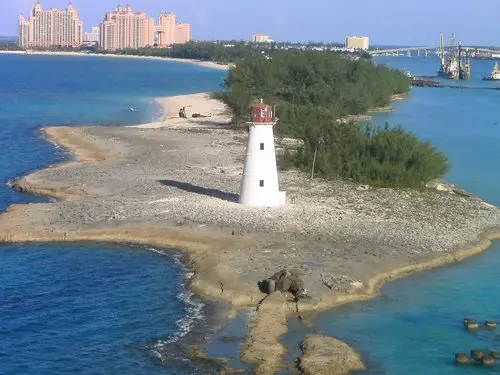
However over the years, several other authors kept extending the area beyond its original boundary because they seemed to identify mysterious incidents in nearby areas as well. Visit Triangle Location & Map to get details about the area, how it is actually laid out on the Atlantic, understand if it actually has a map to identify the location (i.e. latitude / longitude), and whether you will ever know when you are entering the dreaded area as you take a cruise or flight.
Incidents of disappearances: Lost Planes & Ships in Bermuda Triangle
Here are some of the most amazing stories of planes and ships that disappeared or met with ill fate while crossing the triangle area. As you visit the links, you will also see my findings behind such great mysteries of all times. In most cases I have discussed and explained the possible causes, in some cases I have also given excerpts from official reports that were produced by US Navy, US Air Force or US Coast Guards after completing the search operations. And in several cases, I have given updates on further findings.
Flight 19: The Avenger planes of Flight-19 took off from the U.S Naval Base of Florida for a routine training session on an afternoon of December 1945, but strangely this time they never returned.
PBM Martin Mariner: When all hopes for the above Flight-19 planes were quickly fading, two Martin Mariner planes (flying boats) were sent by US Navy to search them out. One came back, but the other didn't and disappeared forever. Read the full story to know what happened.
Tudor Star Tiger: Star Tiger, a Tudor Mark-IV aircraft disappeared in Bermuda Triangle shortly before it was about to land at the Bermuda airport.
Fight DC-3: The flight DC-3 NC16002 disappeared when it was only 50 miles south of Florida and about to land in Miami.
Flight 441: A Super Constellation Naval Airliner disappeared in October 1954.
C-54 Skymaster: Apparently it seemed to be a sudden thunderstorm that had disintegrated the plane. But there was much more to the story.
Mary Celeste - The Ghost Ship: Known as one of the ghost ships of Bermuda Triangle, Mary Celeste had many misadventures even before her mystery voyage in 1872. But this time, although the ship could be salvaged, none on board could ever be traced.
Carroll A. Deering: This is another ghost ship of Bermuda triangle which created one of the biggest maritime mysteries of all times. While returning from Rio de Janeiro of Brazil to Portland in Maine in January 1921, it was found abandoned and derelict at Diamond Shoals, off Cape Hatteras in North Carolina. But all the 11 crewmen including the captain were missing. They vanished for ever and never to be found again.
Marine Sulphur Queen: This 524-foot carrier of molten sulphur started sail on Feb 2, 1963 from Beaumont, Texas with 39 crew. It was reported lost in Florida Straits on February 4, and lost for ever.
Ellen Austin: The Ellen Austin, an American schooner, met with another ship in Bermuda Triangle. The other ship was moving in full speed but strangely had nobody on board.
USS Cyclops: Disappearance of the carrier ship U.S.S. Cyclops in Bermuda Triangle has been one of the greatest mysteries of the sea.
USS Scorpion: USS Scorpion (SSN-589) was a Nuclear powered submarine of United States Navy that disappeared in Bermuda Triangle area in May 1968.
List of Incidents
The above were only few cases. Check out Bermuda Triangle Incidents for a list of all the major indents in the triangle area that took place over the past centuries including the latest ones along with fascinating stories for many.
Popular theories solving the mystery
So what caused the ships and aircraft to disappear mysteriously? There have been many research and explorations done to uncover the mystery. There is no single theory that can explain all the incidents of disappearances. The ships and aircraft could have been victims of different circumstances, and things would have happened quickly and unexpectedly. While many theories have come out trying to explain the various incidents, here are some of the most popular ones including those that took recourse to supernatural powers and events.
Methane Gas trapped under the sea floor can erupt, and as a result can lower the water density and cause ships to sink like a rock. Even planes flying over it, can catch fire and get completely destroyed during such gas blowout.
Sargasso Sea is a strange area that has no shores and bounded only by water currents on all sides. Many ships passing through it have been stranded and made motionless. Many of them were found derelict and without a soul.
Electronic Fog, a strange thick cloud appears from nowhere and engulfs a ship or a plane. Instruments begin to malfunction, and finally the ship or the aircraft vanishes without a trace.
Supernatural Theories: Lost City of Atlantis under the ocean, UFOs, Aliens are also thought to be behind such mysteries.
More Theories...
There are several other theories that try to solve or explain the mysteries of Bermuda Triangle and try to identify factors causing such incidents. Visit Theories of Bermuda Triangle to know about them all.
Conclusion - The Facts
Since a magazine first coined the phrase 'Bermuda Triangle' in early 1950s, the mystery has continued to attract attention. When repeated mysterious incidents of such scale take place in the same area, it's understandable that it would spread like fire, draw large interests among people at all levels including critics and take a mammoth shape over time. Indeed Bermuda Triangle has become a living legend. But what is the real truth behind all this?
Larry Kusche, a librarian in Arizona State University was a big critic of Bermuda Triangle and made a deep research into the incidents and finally published his book 'The Bermuda Triangle Mystery: Solved' in 1975. Most of his research was based on referring newspapers of the periods that reported the incidents, checking out the meteorological (weather) reports of the days the incidents took place etc. He concluded that the total number of such incidents in the triangle area is nothing unusual in a place where tropical cyclones or hurricanes are quite common. His study also showed that number of incidents here is not significantly more compared to several other ocean areas.
Kusche further stated that several authors wrongly reported the incidents. He pointed out a case where an author misreported a ship disappearing three days after it left a port in Atlantic while the fact was the ship actually left a port of the same name from Pacific ocean which was over 3,000 miles away. In another case Kusche showed that an author described a ship getting lost in calm sea while the meteorological report showed a strong cyclone was passing by.
Now read this... Lloyd's is a London based insurance body and active in marine insurance market since long. They insure ships on voyage. When Lloyd's was asked by a UK television channel if they noted unusual number of ships sinking or getting lost in Bermuda Triangle, they answered 'NO'. They further confirmed that they do not even charge higher insurance rates for ships passing through Bermuda Triangle area because they consider it safe. The US Coast Guard also supported Lloyd's observation that the number of reported missing cases in Bermuda Triangle is nothing unusual.
Here is one more... A study conducted in 2013 for WWF (World Wide Fund for Nature) reported the 10 most accident prone ocean areas in the world for shipping, and that does not include Bermuda Triangle. In fact based on accidents recorded, the most dangerous water areas are South China Sea, the Mediterranean and the North Sea.
So does it all mean the notion of Bermuda Triangle being dreaded is baseless? Is it all hunky-dory out there?
Well, there are several questions which still need to be answered before we can come to that conclusion, if at all. Hundreds of ships and planes were actually lost in that area, and many such cases are not yet explained with evidence. It is a fact that authors fanned the fire to take commercial advantage of the situation. But it is hard to believe that a legend of such gigantic nature is just a baseless myth that continues to engulf the world for so many decades. Despite thorough and sustained investigations, numerous incidents continue to baffle the investigators.
Scientists have found some interesting formations on the seafloor within the Bermuda Triangle boundaries. The ocean floor at some places suddenly drop to huge depths. In fact, some locations within the triangle have deepest trenches in the whole of Atlantic. And within this area many vessels were seemingly lost.
It is also a fact that marine and airway corridors across Bermuda Triangle are some of the busiest and most commercially used routes in the world. They are used extensively by numerous cruise lines and airlines connecting The USA, Europe, Caribbean islands, Bermuda, South America and even Africa. Think of what may happen to billions of dollars of thriving international business and its impact on economy if the area gets to be known as dreaded? Will anybody want such flourishing economy to get jeopardized by calling out the area as dangerous?
Relampago del Catatumbo, Ologa, Venezuela

Thanks to its humidity, its elevation and the clash of winds from the mountains and the sea, the southwestern corner of Lake Maracaibo in Venezuela has the world's highest frequency of lightning activity (250 flashes per square kilometer per year).
More than 200 nights per year, with peaks in May and October, lightning flashes fill the sky -- sometimes 25 or more flashes per minute. To put that in perspective: The National Weather Service classifies anything over 12 strikes per minute as "excessive." Named for the Catatumbo River, which flows from Colombia in to Lake Maracaibo, the Relampago de Catatumbo, or Catatumbo Lighting, has become a highlight for travelers who spend their nights wide awake and wide-eyed watching the spectacle.
Old Faithful, Yellowstone National Park
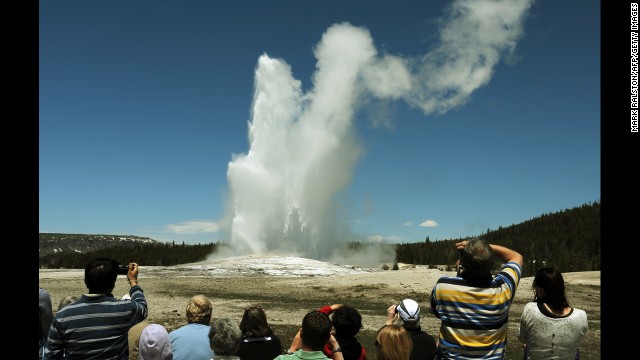
Yellowstone National Park claims the highest concentration of geysers of any place on Earth. Geysers are hot springs with plumbing challenges that result in eruptions. More than 300 can be found throughout the park, and none is more famous than Old Faithful. In fact, Old Faithful is the reason Yellowstone was designated a National Park -- the first in the United States -- in 1872.
Its name comes from the perceived regularity of its eruptions, which occur every 55 to 120 minutes and last for two to five minutes. The spectacular eruptions remain a source of fascination for the more than 3.5 million people who visit Yellowstone each year. The fact that the eruptions aren't quite as regular as they might seem -- and that the mean eruption interval seems to be lengthening -- keeps geologists fascinated, too.
Moeraki Boulders, New Zealand
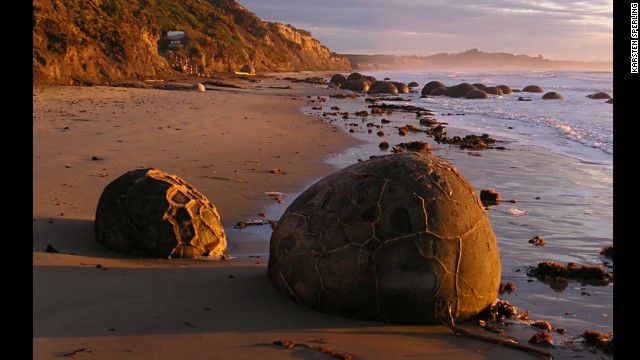
Large spherical boulders -- some measuring 12 feet in circumference -- are scattered on Koekohe Beach on the east coast of New Zealand's South Island. They formed millions of years ago on the ancient sea floor, collecting and hardening sediment and minerals around a core such as a fossil or a shell similar to the way oysters form pearls.
They're not the world's only examples of what geologists call septarian concretions. You can also visit the Koutu Boulders near Hokianga Harbour on the northwestern coast of New Zealand's North Island, for example. Yet the Moeraki Boulders are some of the world's largest. The particulars of their origin and what caused the distinctive cracks inside them are still being studied.
Surtsey, Iceland
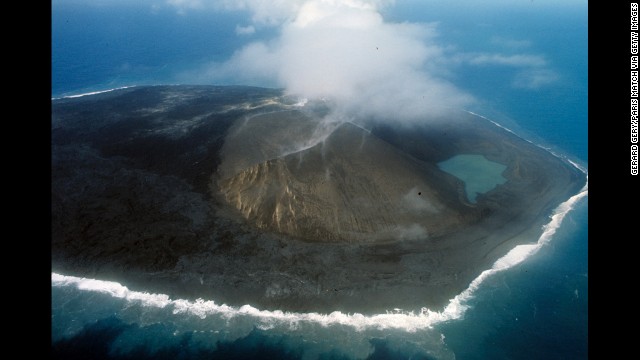
When people try to convince you there's nothing new under the sun, direct them to the Icelandic island of Surtsey. Before 1963, it didn't exist. Then, an underwater volcano in the Westman Islands (Vestmannaeyjar) erupted, and when the activity settled down in 1967, what remained was an island where no island had been before.
Magnetic Hill, Moncton, New Brunswick
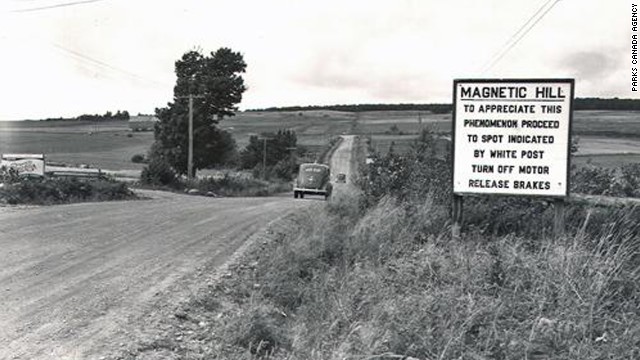
What could possibly cause an automobile to roll backward uphill without power? A magnetic force from within the Earth? Something even more fantastic? Since the 1930s, when the phenomenon of Magnetic Hill was discovered (and almost immediately promoted as a tourist attraction), people have been trying to figure out its riddle.
Blood Falls, Antarctica
Earth never stops surprising us. Every corner of the planet offers some sort of natural peculiarity with an explanation that makes us wish we'd studied harder in junior high Earth science class.
Some of these sites are challenging to get to; others are busy tourist destinations. They keep natural scientists searching for answers and the rest of us astounded by the secrets and mysteries the world continues to reveal.
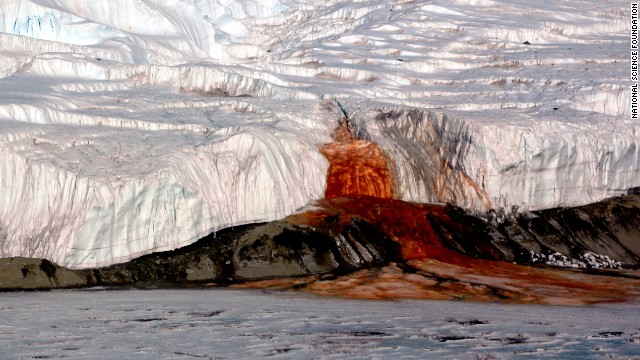
Most people won't see Blood Falls in person, but even in photographs, the sight is arresting: a blood-red waterfall staining the snow-white face of Taylor Glacier. Glaciologists and microbiologists have sought to determine what causes the mysterious red flow. They've concluded that the source is a subterranean lake rich in the iron that gives the water its red hue. Stranger still, recent research has revealed microorganisms living 1,300 feet beneath the ice, sustained by the iron and sulfur in the water.
Saturday, 7 May 2016
Microsoft removes store-blocking from Windows 10 Pro
Businesses running the professional version of Windows 10 can no longer block access to the Windows Store.
Following an update the function is now available only on the more expensive Windows 10 Enterprise version, as well as the Education edition.
Many firms try to prevent staff from downloading additional software as it can cause problems with existing programs and affect productivity.
Microsoft said it had made the change "by design".
"Windows 10 Enterprise is our offering that provides IT pros with the most granular control over company devices," the tech giant said in a statement.
"Windows 10 Pro offers a subset of those capabilities and is recommended for small and mid-size businesses looking for some management controls, but not the full suite necessary for IT pros at larger enterprises."
Educate staff
John Harrison, owner of Harrison IT services, said the change could cause problems for small businesses.
"Users like to change settings or try to install software by themselves. If they don't know what they're doing or don't have the appropriate experience, they can cause all kinds of issues," he said.
"You are going to have to educate staff, tell them not to use the Windows Store unless it really is relevant to the business. How do you manage that policy?"
In September 2015 there were 669,000 apps on the Windows Store, according toMicrosoft's own figures.
Microsoft says there are 300 million devices using Windows 10 one year after its launch.
On 29 July, a free upgrade offer for Windows users with earlier versions of the operating system will come to an end.
India's new 'enclave' citizens in historic first vote

Thousands of people living in enclaves along the Bangladesh border have voted for the first time in India after remaining virtually stateless for six decades.
They became citizens of India last year after Bangladesh and India exchanged more than 160 enclaves located in each other's territory. The enclaves, created in the 18th Century, endured through British colonial rule, the independence of India and the creation of Bangladesh.
On Thursday, the new citizens got their first taste of democracy when they voted in the West Bengal state assembly elections.
Photojournalist Ronny Sen captured the historic occasion.
The 103-year-old first-time voter

Asgar Ali (centre) is 103 years old and voted for the first time in Moshaldanga in Cooch Behar district. Three generations of his family, including his son and grandson, accompanied him to the polling booth. His grandson Jaynal Abedin was keen to mark the occasion with a selfie.
'Freedom after 200 years'

Abdul Mannan, 61, is a resident of Poaturkuthi, the largest enclave with 1,800 voters. He said three generations of his family lived and died there without an official identity for nearly two centuries. "Today, after nearly 200 years, we got freedom. We have an identity. We had nothing earlier," he said.

'Finally included'
Maksedul Hoque, 29, said he would often feel left out when his friends from mainland India would talk about politics and elections. "It's something I grew up watching but was never a part of, and that made me feel excluded," he told the BBC. Now after voting, he says he feels more empowered and included. He wants the candidate he voted for to build new roads, hospitals, schools and create jobs for young people.
'Excited to vote'

Bashanti Shil, 90, came to the polling booth with her grandson Sudama Shil, who is 30. She said she was "very excited" to vote and hoped that participating in elections would bring prosperity and happiness to her family members and everyone in the enclave of Moshaldanga.
A part of the process

Mizanur Rahman, 37, and his wife Arjina Aktar, 20, excitedly show off their new voting ID cards. Mr Rahman said he wasn't allowed to vote in Bangladesh but saw political campaigns and always wanted to be a part of the process. He said he wanted politicians to fulfil promises to bring growth and prosperity to the region. He added that he hoped for free movement of people between the Indian and Bangladeshi enclaves.
Voting for development

Rokeya Bibi (right), 20, went to the polling booth with her mother-in-law Majia Bibi. "I want schools and colleges in this area so that my children don't have to travel far," Rokeya Bibi said.
Subscribe to:
Posts (Atom)
